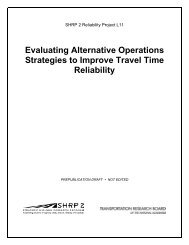Contemporary Approaches to Parking Pricing: - FHWA Operations
Contemporary Approaches to Parking Pricing: - FHWA Operations
Contemporary Approaches to Parking Pricing: - FHWA Operations
Create successful ePaper yourself
Turn your PDF publications into a flip-book with our unique Google optimized e-Paper software.
2.2 Performance-based <strong>Pricing</strong><br />
Fixed-rate pricing has been the standard parking-pricing option for cities since the parking meter was introduced.<br />
While it may not adequately price parking, it does have advantages. The pricing scheme can be implemented with<br />
mechanical meters, requires no additional special equipment, and does not require the collection of data regarding<br />
parking utilization and availability. Unfortunately, fixed-rate pricing fails <strong>to</strong> manage parking supply.<br />
<strong>Pricing</strong> parking based on performance goals for the street or transportation system, often called performance-based<br />
pricing, allows cities <strong>to</strong> better manage the parking supply. <strong>Parking</strong> experts generally agree that 10 <strong>to</strong> 20 percent (one<br />
or two spaces) of on-street parking per block should be vacant most of the time as a way <strong>to</strong> reduce or eliminate<br />
cruising for parking (BPR, 1956; Levy, et al. 2012). Higher vacancy rates may be a sign that pricing is <strong>to</strong>o high.<br />
While a vacancy rate of 10 <strong>to</strong> 20 percent might be the most common performance goal used by cities, other goals<br />
can be considered as well. <strong>Pricing</strong> can be set <strong>to</strong> drive turnover, maximize value extraction, and transition travelers<br />
away from private au<strong>to</strong>mobiles <strong>to</strong> more sustainable travel modes. In any case, the performance standard is met<br />
through various pricing schemes, including rates that escalate the longer a person is parked, prices that vary by location,<br />
prices that vary by time of day, or a combination of these options.<br />
Implementing a performance-based pricing program begins with understanding the local parking context and establishing<br />
a balance between parking supply, both on street and off, and demand. Accurate and up-<strong>to</strong>-date supply<br />
and demand data are helpful <strong>to</strong> determine appropriate parking rates, but the rates can be set empirically as well. San<br />
Francisco and Seattle are good examples of cities that are empirically setting rates <strong>to</strong> reduce cruising. San Francisco<br />
has taken a complex approach with the aid of “smart” meters that can accommodate multiple forms of payment,<br />
charge variable parking rates, and record data regarding usage and duration of use; parking sensors; and a very advanced<br />
data collection system, whereas Seattle is experimenting with a low-technology approach that focuses on<br />
manual measurements of on-street parking conditions. Both cities seek <strong>to</strong> set rates that assure an appropriate level<br />
of available space (see the Seattle case study in section 7 and the San Francisco callout at the end of this section).<br />
Variable Rates<br />
<strong>Parking</strong> rates should be allowed <strong>to</strong> vary across a variety of dimensions. One dimension should be geographical, as<br />
some areas of a city will have greater parking demand than others. Rates should also vary by time of day, which is<br />
already a common practice as meter rates are typically in effect only during daytime hours and overnight parking is<br />
free. A few cities, New York City and San Francisco being notable examples, have implemented differential parking<br />
rates that vary by time of day based on changes in parking demand. New York City implemented variable parking<br />
rates in two pilot neighborhoods. In one neighborhood the peak rate is charged between 12:00 p.m. and 7:00 p.m.<br />
and in the other neighborhood the peak rate is charged between 6:00 p.m. and 10:00 p.m. As in most meter applications,<br />
overnight parking is still free, leaving three distinct price regimes throughout the day. Rates should also vary<br />
across days of the week, as some areas will have higher demand on weekdays than weekends and vice versa. They<br />
should also vary across time more generally: as inflation erodes prices and as areas gain or decline in popularity,<br />
meter rates should fluctuate <strong>to</strong> reflect these realities.<br />
A somewhat controversial approach is <strong>to</strong> vary prices in real-time, which the District of Columbia is proposing <strong>to</strong><br />
pilot for some on-street commercial vehicle parking. This approach is analogous <strong>to</strong> a travel lane that is priced <strong>to</strong><br />
ensure a particular travel time. As parking utilization on a given block increases, the price escalates from a base<br />
C o n t e m p o r a r y A p p r o a c h e s t o P a r k i n g P r i c i n g | 5















